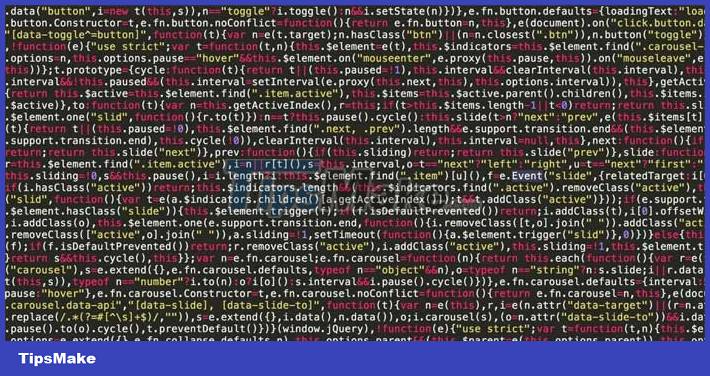Difference between XML, JSON and YAML
XML, JSON, and YAML are all data-centric languages. So how can you use them? Let's find out with TipsMake!

A data string language represents structured data in a format that can be stored, transmitted, and reproduced later. These languages are necessary because they convert data into a standard format that you can use across different languages and platforms.
XML, JSON, and YAML are the most popular data string languages in use today. This article will give you the basic knowledge and the striking differences between them.
What is XML?
XML (eXtensible Markup Language) is a language that defines instructions for encoding documents in a way that both humans and machines can understand. This markup language is similar to HTML but does not have tags available. Instead, it allows you to create custom tags according to your needs. These are called self-identifying tags.
This markup language is self-describing, making it versatile and popular for organizing and structuring data on the Internet. Data shared using XML works across multiple platforms and is suitable for different uses. This makes XML an essential tool in building networks, converting and storing data in many different fields.
How to write XML
In XML, you use tags to wrap data, just like in HTML. You have two types of tags:
- A normal tag has an opening tag (eg: ) and a corresponding closing tag (eg: ).
- Self-closing tags, like
.
You may find it helpful to use an online XML editor to write and format the document. Editing tools like these are accessible, support collaborative editing, and integrate authentication.
This is an illustrative example of an XML file. Tags include data about an individual, using embedded tags to represent their name and age.
John 30 Advantages of XML
Here are some benefits of using XML:
- XML is very well supported by Java.
- You can define the valid structure of an XML document using Schema or DTD. This ensures that the document is correct at the semantic level.
- You can use XML to convert data between different formats, such as converting database queries to XML documents.
What is JSON?
JSON is the abbreviation for JavaScript Object Notation. It is a compact format for storing and converting data. Originally designed for JavaScript, JSON has become popular thanks to its simple structure. However, since then, many fields have adopted the language, making it the most popular way to convert data on the Internet.
You can also use JSON files to share data between web servers and websites, for configuration files and in situations where you need to organize and transfer data. Similar to a dictionary in Python, JSON data consists of nested lists and dictionaries, making it more like a key-value data structure.

How to write JSON
Here is an example of a simple JSON data file:
{ "name": "John", "age": 30, "city": "New York" } JSON uses syntax borrowed from JavaScript to represent basic data types such as integers, strings, and booleans. It also supports arrays, using square brackets, and objects, using key-value pairs between braces.
Most programming languages support JSON. You can read and write JSON data with Node.js, do the same with Rust, and use JSON with Go.
Advantages of JSON
Here are some advantages of JSON:
- JSON is short and concise, making data analysis and generation faster. It supports a small but useful range of data types such as strings, numbers, booleans, arrays and objects.
- Most programming languages support JSON along with helper functions and libraries.
- JSON often acts as a data conversion format in APIs, allowing the server to send data to a website or application.
What is YAML?
YAML (YAML Ain't Markup Language) is a markup language widely used in configuration files for DevOps tools/programs/applications. It is famous for its simplicity compared to XML and JSON. It uses indentation and newlines to separate data instead of symbols and braces. You can also use this language with other languages, such as Go.
However, it is not a beginner-friendly language. This can lead to validation errors, for example you cannot indent the data correctly.
How to write YAML
Example of YAML file:
Employees: - name: Alice Johnson Department: Marketing country: Canada - name: Carlos Rodriguez Department: Finance country: SpainThis YAML document contains a list of employees, each element has the following properties:
- Name : Employee name (e.g. Alice Johnson, Carlos Rodriguez).
- Department : The department the employee works in (for example: marketing, finance department).
- Country : The country in which the employee works (e.g. Canada, Spain).
Advantages of YAML
- YAML is the simplest data string language in use today.
- Other than JSON, YAML supports comments.
- YAML also includes support for more complex data structures such as anchors and aliases.
YAML, XML, and JSON are all data exchange formats with their own strengths and uses. Choosing between these formats depends on the specific requirements of the project.
YAML excels in configurability and readability, XML provides extensibility and validation, and JSON has the advantage of efficiency and is widely supported in modern web programming. Understanding the strengths and characteristics of each format will help you choose the most suitable language.
 How to create phone wallpaper using DALL-E
How to create phone wallpaper using DALL-E How to install WPS Office on Ubuntu
How to install WPS Office on Ubuntu What is HDCP error? How can it be fixed?
What is HDCP error? How can it be fixed? 7 best note-taking apps for students
7 best note-taking apps for students The 10 biggest crypto hacks and scams of 2023
The 10 biggest crypto hacks and scams of 2023 How many times has LastPass been hacked? Is it still safe to use?
How many times has LastPass been hacked? Is it still safe to use?